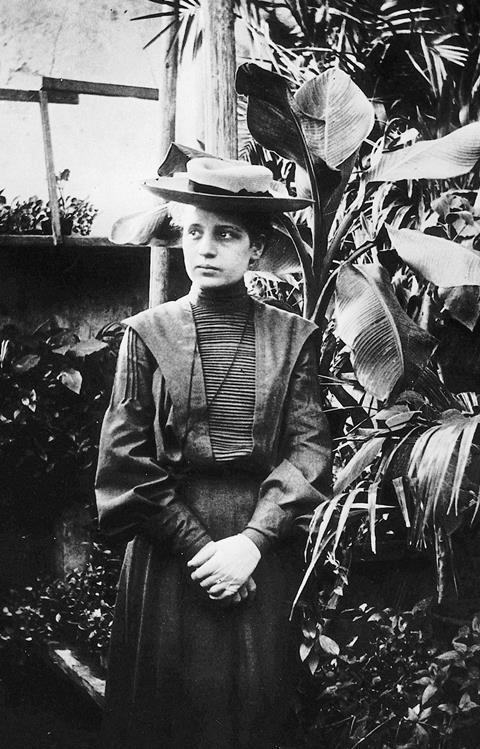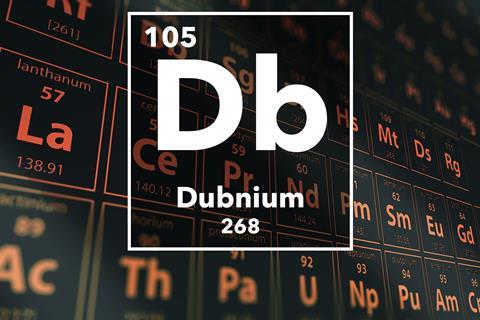Meera Senthilingham
This week: warfare, as the US and Russia fight to find new elements. Simon Cotton:
Simon Cotton
In the days of the Cold War, America and Russia rivalled each other in all sorts of ways. Never mind thermonuclear bombs and intercontinental ballistic missiles to deliver them, they competed in putting men and women into space; who could win the most medals in the Olympic Games; and in making new chemical elements. In the case of element 105, the controversy went on for nearly 30 years and was part of the so-called 'Transfermium Wars', when no blood was spilt but a great deal of ink was.
In the Red corner, the Soviet team at the Joint Institute for Nuclear Research at Dubna, near Moscow, led by Georgy Flerov. In the Blue corner, the American team at the University of California at Berkeley, led by Albert Ghiorso.

In 1968, the Soviet team bombarded an americium-243 target with neon-22 and claimed to have made isotopes of mass 260 or 261 of element 105. First round to Russia. Two years later, the Berkeley group reported bombarding californium 249 with nitrogen-15, and claimed they had made an isotope of element 105 of mass 260 with a half life of around 1.5 seconds. They showed its alpha-decay product was element 103, lawrencium. They gave it the name hahnium, after Otto Hahn, who received the 1944 Nobel Prize in Chemistry for the discovery of nuclear fission. Lise Meitner, a collaborator of Hahn, who had predicted fission, did not get even a mention from the Nobel committee, but more on this later. Also in 1970, the Russians reported more results, with more convincing data. They named it nielsbohrium, after the Danish physicist who was awarded the 1922 Nobel Prize for Physics for his researches on atomic structure and radiation.
As time went on, studies from both laboratories continued, and evidence mounted that element 105 resembled niobium and tantalum, being a member of a 6d transition series. In 1986, the Transfermium Working Group was set up to determine firstly, the criteria that must be satisfied for the discovery of a new chemical element to be recognised and secondly to apply these criteria to the discovery of the transfermium elements. For the time being, in view of the conflicting claims, they kicked for touch and proposed a temporary name of unnilpentium (symbol Unp) while they decided who had synthesised and characterised this element. In 1994, they suggested the name joliotium (Jl), after the French physicist Frederic Joliot-Curie, but this did not find acceptance. Finally in 1997, the working group recognised that both Berkeley and Dubna had made 'significant contributions' to the discovery of elements 104 and 105, and said that since the Berkeley contributions were recognised in the names of elements 104 and 106 (rutherfordium and seaborgium), element 105 should be given the name dubnium, symbol Db, after the town the Russian scientists came from.
Although only a few atoms have ever been made, we know a bit about the chemistry of dubnium. We think that its aqua ion adopts the +5 oxidation state, as the dubnium aqua ion is adsorbed onto glass from solution, just like niobium and tantalum above it in Group 5 – but unlike +3 and +4 ions of lanthanide and actinide metals. Attempts to form fluoride complexes in solution suggest that Db resembles niobium more than tantalum. Chemists have also made some chlorides and bromides, though they may possibly have been studying oxyhalides.

Element 105 has had five names in total, being reinvented almost as often as Madonna.
I mentioned earlier that the American team called it hahnium until 1997; well, now it has been rejected, this name can never be used for the name of an element, whereas in 1997 meitnerium was adopted as the name for element 109. That's right, Otto Hahn got a Nobel prize but no element named after him, whereas Lise Meitner, his co-worker, got no Nobel prize, but an element named after her. In the words that William Shakespeare puts into the mouth of a clown in Twelfth Night 'the whirligig of time brings in his revenges'.
Meera Senthilingham
So all is fair in the world of chemistry, kind of. That was Uppingham School's Simon Cotton bringing us the competitive discovery of dubnium. Now, staying with the transactinides, and the much deserved recognition of Lise Meitner; next week, we discover the chemistry of Meitnerium
Nik Kaltsoyannis
Meitnerium and the other transactinide elements do not exist in ature. They are all man made and have been synthesised in only fantastically small quantities, by combining the atoms of two lighter elements. They are all highly radioactive, with very short half-lives, severely limiting the practical chemistry that can be performed on them. Indeed, entirely new experimental techniques, collectively known as "atom at a time" methods, have been developed to study these elements. In these experiments we are not working with moles of atoms, or even recognisable fractions of moles, but literally with single atoms.
Meera Senthilingham
And to find out how these techniques can be performed with such precision, join UCL's Nik Kaltsoyannis in next week's Chemistry in its element. Until then, I'm Meera Senthilingham and thank you for listening!













No comments yet